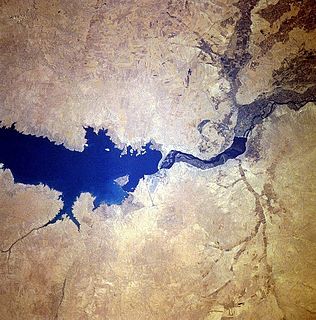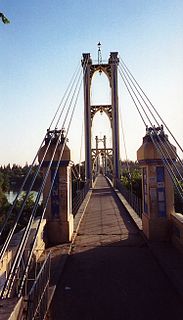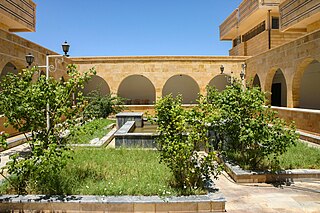
The Euphrates is the longest and one of the most historically important rivers of Western Asia. Together with the Tigris, it is one of the two defining rivers of Mesopotamia. Originating in Turkey, the Euphrates flows through Syria and Iraq to join the Tigris in the Shatt al-Arab, which empties into the Persian Gulf.

Deir ez-Zor is the largest city in eastern Syria and the seventh largest in the country. Located 450 km (280 mi) to the northeast of the capital Damascus on the banks of the Euphrates River, Deir ez-Zor is the capital of the Deir ez-Zor Governorate. In the 2018 census, it had a population of 2,718,000 people.

The Tabqa Dam, or al-Thawra Dam as it is also named, most commonly known as Euphrates Dam, is an earthen dam on the Euphrates, located 40 kilometres (25 mi) upstream from the city of Raqqa in Raqqa Governorate, Syria. The city of Al-Thawrah is located immediately south of the dam. The dam is 60 metres (200 ft) high and 4.5 kilometres (2.8 mi) long and is the largest dam in Syria. Its construction led to the creation of Lake Assad, Syria's largest water reservoir. The dam was constructed between 1968 and 1973 with help from the Soviet Union. At the same time, an international effort was made to excavate and document as many archaeological remains as possible in the area of the future lake before they would be flooded by the rising water. When the flow of the Euphrates was reduced in 1974 to fill the lake behind the dam, a dispute broke out between Syria and Iraq that was settled by intervention from Saudi Arabia and the Soviet Union. The dam was originally built to generate hydroelectric power, as well as irrigate lands on both sides of the Euphrates. The dam has not reached its full potential in either of these objectives.

The Keban Dam is a hydroelectric dam on the Euphrates, located in the Elazığ Province of Turkey. The dam was the first and uppermost of several large-scale dams to be built on the Euphrates by Turkey. Although the Keban Dam was not originally constructed as a part of the Southeastern Anatolia Project (GAP), it is now a fully integrated component of the project, which aims to stimulate economic development in Southeastern Turkey. Construction of the dam commenced in 1966 and was completed in 1974. Keban Dam Lake, the reservoir created by Keban Dam, has a surface area of 675 square kilometres (261 sq mi) and is reputedly the fourth-largest lake in Turkey after Lake Van, Lake Tuz, and the reservoir created by the Atatürk Dam.

Abu Kamal or Al-Bukamal is a city on the Euphrates river in the Deir ez-Zor Governorate of eastern Syria near the border with Iraq. It is the administrative centre of the Abu Kamal District and the local subdistrict. Just to the south-east is the Al-Qa'im border crossing to the town of Husaybah in the Al-Qa'im District of Iraq's Al Anbar Governorate.

Deir ez-Zor Governorate is one of the fourteen governorates (provinces) of Syria. It is situated in eastern Syria, bordering Iraq. It has an area of 33,060 km2 and a population of 1,239,000. The capital is Deir ez-Zor. It is divided roughly equally from northwest to southeast by the Euphrates. Most of the territory on the river's left bank is part of the Autonomous Administration of North and East Syria, while that on the right bank is controlled by the Syrian government.

Lake Assad is a reservoir on the Euphrates in Raqqa Governorate, Syria. It was created in 1974 when construction of the Tabqa Dam was completed. Lake Assad is Syria's largest lake, with a maximum capacity of 11.7 cubic kilometres (2.8 cu mi) and a maximum surface area of 610 square kilometres (240 sq mi). A vast network of canals uses water from Lake Assad to irrigate lands on both sides of the Euphrates. In addition, the lake provides drinking water for the city of Aleppo and supports a fishing industry. The shores of Lake Assad have developed into important ecological zones.

The Deir ez-Zor suspension bridge was a pedestrian suspension bridge crossing the Euphrates River, in the city of Deir ez-Zor in north-eastern Syria.

Halabiye is an archaeological site on the right bank of the Euphrates River in Deir ez-Zor Governorate, Syria. It was an ancient city and former bishopric known as Zenobia and a Latin Catholic titular see.

Zalabiye is an archaeological site on the left bank of the Euphrates in Deir ez-Zor Governorate, Syria.

The Tishrin Dam is a dam on the Euphrates, located 90 kilometres (56 mi) east of Aleppo in Aleppo Governorate, Syria. The dam is 40 metres (130 ft) high and has 6 water turbines capable of producing 630 MW. Construction lasted between 1991 and 1999. Rescue excavations in the area that would be flooded by the dam's reservoir have provided important information on ancient settlement in the area from the Pre-Pottery Neolithic A (PPNA) period upward.

The Deir ez-Zor Museum is a museum devoted to the archaeology and history of northeastern Syria, an area more commonly known as the Jezirah, or Upper Mesopotamia. The museum is located in Deir ez-Zor, the capital of Deir ez-Zor Governorate, Syria. It was founded in 1974 and housed in a gallery of a shopping mall. Between 1983 and 1996, it was located in an old law court built in 1930. In 1996, the museum moved to its current location in a building that had been especially designed for the museum. The exhibition halls cover an area of 1,600 square metres (17,000 sq ft) and are arranged around a courtyard. The construction of the new museum was a joint Syrian–German operation.

Al-Asharah is a town in eastern Syria, administratively part of the Deir ez-Zor Governorate, located along the Euphrates River, south of Deir ez-Zor. Nearby localities include al-Quriyah to the northeast, Makhan and Mayadin to the north, Suwaydan Jazirah to the southeast and Dablan to the south. According to the Syria Central Bureau of Statistics, al-Asharah had a population of 17,537 in the 2004 census. It is the administrative seat of a nahiyah ("subdistrict") which consists of seven localities with a total population of 96,001 in 2004. Al-Asharah is the third largest locality in the nahiyah. Its inhabitants are predominantly Sunni Muslims. From Arabians Tribes of Tayy Al-Rahabi and Al Uqaydat.

The Deir ez-Zor Governorate campaign of the Syrian civil war consists of several battles and offensives fought across the governorate of Syria:

The Battle of Deir ez-Zor was a large-scale siege imposed by the Islamic State of Iraq and the Levant (ISIL) against several districts in the city of Deir ez-Zor held by the Syrian Army, in an attempt to capture the city and secure full control of the Deir ez-Zor Governorate. The ISIL siege of the city lasted for almost 3 years and 2 months, after which the Syrian Army launched a successful offensive that fully recaptured the city nine weeks later.
The following is a timeline of the Syrian Civil War from September to December 2017. Information about aggregated casualty counts is found at Casualties of the Syrian Civil War.
The 2017 Euphrates Crossing offensive was a military offensive launched by the Syrian Arab Army against members of the Islamic State of Iraq and the Levant (ISIL) in the Deir ez-Zor Governorate, following the breaking of the three-year siege of the city of Deir ez-Zor. The Euphrates Crossing offensive, conducted by government troops, was done with the aim of denying US-backed Syrian Democratic Forces and the US itself leverage over the Syrian government.

The Deir ez-Zor offensive was a military operation launched by the Syrian Armed Forces to completely expel the Islamic State of Iraq and the Levant (ISIL) from the city of Deir ez-Zor, a provincial capital, located on the banks of the Euphrates river. From 2014 until 2017, the city had been divided into Syrian government and ISIL-controlled halves. The rest of the Governorate (province) was under ISIL control for most of this time, putting the government-controlled half of the city under siege.

The Eastern Syria campaign of September–December 2017 was a large-scale military operation of the Syrian Army (SAA) and its allies against the Islamic State of Iraq and the Levant (ISIL) during the Syrian Civil War. Its goal was to clear the city of Deir ez-Zor of any remaining ISIL forces, capture ISIL's de facto capital of Mayadin, as well as seize the border town of Abu Kamal, which became one of ISIL's final urban strongholds by the latter stages of the campaign.
On 29 April 2018, clashes took place between Syrian government forces and the Syrian Democratic Forces (SDF) in Deir ez-Zor Governorate.
















